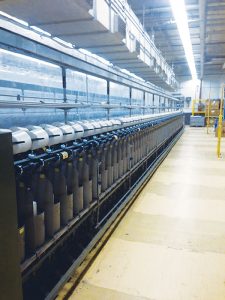
manufacturing as a yarn spinning
company, but in more recent years has
added nonwovens and craft products to
its portfolio of businesses.
National Spinning, a diversified company with its origins in yarn spinning, celebrates its centennial in 2021.
TW Special Report
Washington, N.C.-based National Spinning Co. Inc. has reached a very impressive milestone. Founded in 1921, the company celebrating its 100th anniversary this year. During its 100-year-history, the yarn spinning company — highly skilled at producing wool, acrylic and complex blended yarns, as well as tailored yarns to meet customer needs —has expanded beyond its core spinning competencies with the acquisitions of craft company Hampton Art and airlaid nonwovens producer Carolina Nonwovens.
The company strives to be a reliable trustworthy partner and a go-to resource offering quality products and service in a most professional way to create financial health for itself, its customers and its suppliers.
“We get satisfaction out of delighting our customers, while providing a positive work environment for our associates and being good corporate citizens,” said President and CEO Jim Booterbaugh.
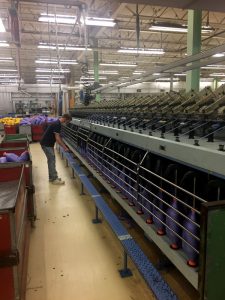
Company History
Established in 1921 by Phillip and Carl Leff in Brooklyn, N.Y., National Spinning initially sold wool yarns to the New York apparel trade.
With the formation of National Worsted Mills in 1934 in Jamestown, N.Y., the company officially became a manufacturer in its own right. In 1954, the company shifted its manufacturing south to Washington, N.C., at which time National Spinning became an early adopter of man-made fibers such as acrylic and nylon as alternatives to wool.
During the 1960s, the company expanded its manufacturing footprint with additional plants in Whiteville, Warsaw and Beulaville, N.C. Over the ensuing several decades, National Spinning became the dominant U.S. manufacturer of natural, fiber-dyed and yarn-dyed acrylic yarn. Its strong capabilities in colored acrylic yarn manufacturing and increase consumer demand, National Spinning became a wholesale manufacturer and distributor of craft yarns and yarn kits in the 1970s using the National Yarn Crafts branding. The company’s acquisition of Tina of California and Caron Spinning expanded this business area.
In the early 1990s, National Spinning became employee-owned via an Employee Stock Ownership Plan (ESOP). Today, employees continue to hold a 50 percent share in the company.
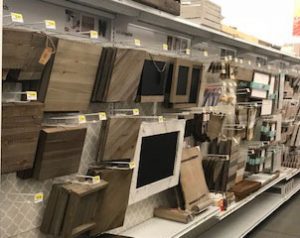
21st Century Diversification
During the 2000s, National Spinning embarked on a diversification plan to move beyond the apparel and craft yarn markets that had been so important to the company’s roots. In 2004, the company bought Hampton Art to grow within the craft space — a decision made because of the company’s connections to the craft industry through its craft yarn sales. Hampton Art has grown into a major distributor of non-textile craft supplies to major craft retailers. Its focus is on DIY supplies for scrapbooking, home décor, weddings and party supplies.
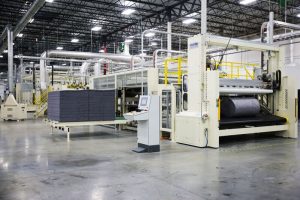
Another major part of the diversification effort took place in 2012 when National Spinning bought Carolina Nonwovens, a producer of airlaid nonwoven pads based in Lincolnton, N.C. Such pads find applications in the automotive, appliance, construction, bedding and cold chain packaging markets. Growth of the business between 2012 and 2015 necessitated an expansion, and the business was relocated to Maiden, N.C., in 2016.
“Over the past 15 years, National’s yarn business has evolved from predominantly wool and acrylic for apparel, to a broad mix of various fibers for technical applications,” said Booterbaugh, a National Spinning employee since 2003. “The current product line still includes wool and acrylic, but yarns are now made using fire resistant fibers such as modacrylic, Nomex®, Conex®, FR rayon and PyroTex®. In addition, fibers such as polypropylene, nylon and Twaron® are spun for industrial applications.”
Changing Of The Guard
Booterbaugh added the title of CEO after his name in 2018. In 2020, well-known industry figure and National Spinning Chairman Jim Chesnutt retired leaving Booterbaugh solo at the helm of the company. “Jim still has an office across the hall from mine and I see him on a regular basis,” Booterbaugh said. “He’s been a mentor for me for 20 years and we maintain a strong line of communication. I’m fortunate to have him as a mentor because he’s just been such a solid contributor to the textile industry over the years.”
Chesnutt remains on the board of directors, but last year, he handed the chairman role to Bob Miller, who is a member of the company’s founding family. “Bob brings a great historical perspective, experience with wool and acrylic sourcing, and a passion for environmental stewardship to the table,” Booterbaugh noted.
Textile World recently had the opportunity speak with Booterbaugh to discuss the centennial milestone, and how the company has positioned itself to remain on a successful path for many more years to come.
TW: What type of spinning technologies does National Spinning employ today? Are there certain technologies the company has invested in over the years that have helped differentiate the company and its products?
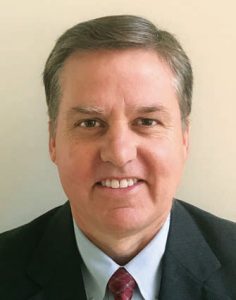
Booterbaugh: National Spinning is one of the few remaining companies with long staple worsted spinning for fibers between 60 millimeters and 120 millimeters. This technology is ideally suited for wool and high bulk acrylic — including hand knitting yarns, hosiery and sweaters — but it is becoming more popular for technical fibers and certain industrial products that require the additional strength, bulk or luster from long fibers as well. Short staple ring spinning is available for polyester, pigmented acrylic and fire-resistant blends.
We also have some spinning equipment for very heavy yarn counts in the range of 0.5/1 to 3/1 — 1,800 to 10,000 denier — for special industrial applications. All yarns can be twisted.
The most interesting/different capability National Spinning has is our specialty blending operation. Because some customers require small percentages of fibers in a blend or greater than three fiber components, National Spinning has a blending facility that provides the most thorough blending available. The unit also allows for the use of multi-fiber blends that are difficult to handle under normal circumstances in a spinning plant.
Whereas this equipment was previously only for internal use, it is now available for customers who just want fiber rather than finished yarns.
TW: Do you have any brands that you promote within the industry? Do you promote any brands at the consumer level?
Booterbaugh: Our premier polyester hosiery brand is called UltraSpun®. It is a proprietary blend of polyester that offers enhanced wicking in addition to a soft hand.
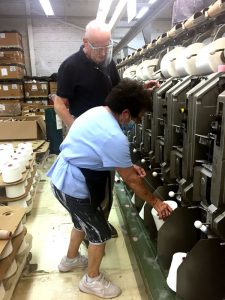
TW: The company turns 100 this year. Do you have any special celebrations planned?
Booterbaugh: We plan to have celebrations at all of our plants in September. In addition, to a celebratory meal, we will have gifts for all of our associates and a raffle with some large prizes. We will also present a historical timeline in the plants, recognizing critical steps in the company journey.
TW: As a 100-year-old spinning company, how has diversifying and broadening your product base allowed you to combat changes in the industry?
Booterbaugh: Diversification has been critical to survival. Not only have we needed to diversify our yarn business, but it has been important to diversify our overall business into nonwovens and crafts to weather the inevitable storms. Diversification also helps us balance out seasonality.
TW: What made the company consider nonwovens when it was looking to diversify?
Booterbaugh: We saw a sector of the industry that was growing and was continuing to grow, and we were able to use fibers. For 90 years, National Spinning took fiber and turned it into a card sliver and then into a yarn. For nonwovens, in the back process you’re still handling fibers in the same way, but instead of turning it into sliver, it instead is made into a mat.
So, it wasn’t a huge leap technology-wise for a spinning company to move into airlaid nonwovens. We looked around and found a company that wanted to sell, and advertised, we’ve seen consistent growth and there’s a lot of flexibility and directions we can go with our product. The business also is very much import resistant because our products are very light and it’s expensive to ship them over long distances.
It puts us in some different markets too — the automotive sector, construction, bedding and appliance products. It’s a totally different product mix and market than for the yarn division and that’s great for the diversification because if the automotive market goes down, it affects our nonwovens division, but it doesn’t really affect our yarn division. And if apparel goes down, it affects our yarn division, but it doesn’t affect our nonwovens.
The other thing that we really liked about the nonwovens business is that we have the ability to use recycled fibers. A large component of what we use are industrial cutting scraps from apparel mills. We have a main product line that is predominantly made using repurposed denim scraps. One of the synergies that we thought could work was to take the waste from our yarn manufacturing operation to repurpose it into nonwovens. We’re not doing that directly yet, but at some point in time there could be a direct waste connection between our spinning and nonwoven operations.
On the nonwovens side, we can handle short recycled fibers. It’s a little bit tougher for the spinning machines, but with nonwovens we can run the post-industrial or post-consumer waste without a problem. We can also handle jute and hemp and other natural fibers a lot easier in our nonwovens process than the spinning process at this point in time.
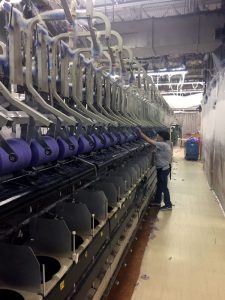
TW: What is the company’s philosophy on traceability and sustainability — both growing industry trends?
Booterbaugh: We participate in several programs that demonstrate our focus on sustainability and ethical practices. One example is the use of wool certified through the responsible wool sourcing (RWS) program, which is a traceable, certified program to ensure that sheep, land, and people are managed ethically and sustainably standards. Some of that yarn will be used in uniforms provided by Ralph Lauren for the Olympics. We also are developing programs using hemp fibers, and we have been spinning yarns from post-consumer, recycled polyester for quite some time.
In our nonwovens division, the majority of the fiber that we use is recycled from industrial and/or post-consumer cutting scraps.
TW: Please expand on the company’s experience with hemp — another growing area of interest for the textile industry that is frequently in the news at the moment.
Booterbaugh: On the fiber side, we get contacted continually with people wondering if we can spin hemp, so we’ve been interacting with many hemp producers to find the ideal fiber hemp growers in the United States.
Our spinning equipment lends itself well to hemp if it’s processed right. Naturally, when hemp comes off the stalk, it’s a very long fiber. So theoretically, we should be able to get very long fibers that match up very well with wool for processing. But as the fiber is removed from the hemp plant and processed before it reaches the spinning mill, the length gets degraded to the point where, as of right now, the best hemp they are able to produce has been knocked down to about 1 inch in length. This length really processes better on the short-staple systems to blend with cotton or polyester. But we’re still hoping for a long-length hemp that can blend with wool effectively.
Hemp fits in with our core competencies with long-staple spinning and wool. We like anything that we can blend with wool, so hemp seems like the perfect partner.
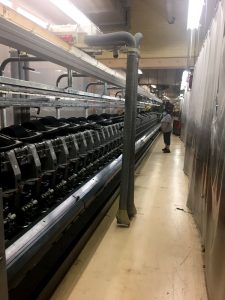
TW: How does your workforce contribute to producing a high-quality product? Do you have skilled workers with a long history at the company?
Booterbaugh: In any business, you will only be as good as the strength of the team. We have an incredible group of long-term associates that bring tremendous experience and skill to the table. We have two associates with more than 50 years of tenure at National Spinning, and they are still going strong.
TW: What are the challenges you encounter running a spinning operation in the United States?
Booterbaugh: It is extremely difficult to compete with foreign competition on price, because we pay more for fiber and labor than our eastern competitors. As a result, we don’t do any commodity business. Our customers buy yarn from us for quick response or special yarns that are not available readily from overseas.
The U.S. supply chains that still exist are critical for supplying products to our government and to customers that require a dependable flow of product. There is still room for U.S. spinners and fabric manufacturers to fill that space.
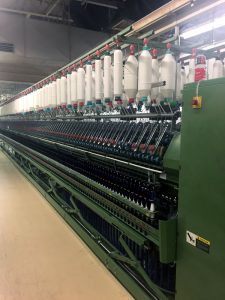
TW: How did the COVID-19 pandemic impact the company? Did you see demand for certain products change?
Booterbaugh: The COVID-19 crisis caused a major interruption in several yarn markets, particularly those related to apparel and protective gear. Some of that reduction in business was covered by demands for yarns that were used for PPE products, but the PPE business was just a small portion of normal business.
One bright spot during the pandemic was the demand for hand knitting yarns and craft sales. COVID created the cocooning effect — a phenomenon that’s seen during really cold winter months when people are staying at home and need things to do inside. People often turn to hand knitting or crocheting, or scrapbooking and other home crafts. This cocooning effect caused a huge increase in hand knitting yarns and craft sales, which helped us weather the storm of the pandemic.
Along those lines, our entire craft division was impacted far less than the textile divisions, and the nonwovens division recovered much quicker than the yarn business. It was a clear demonstration on the value of diversification within a company.
The nonwovens division is critical to our spinning division as is our craft division, because all three divisions support and contribute to the corporate overhead. When one does well, it helps them all.
March/April 2021




